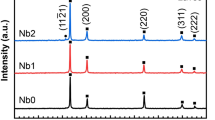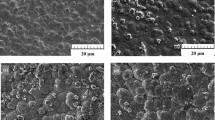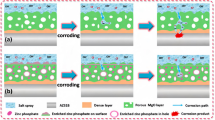Abstract
Samples of Cu-Te-Se alloys, previously aged or treated as a solid solution, were immersed in 3.5% (mass fraction) sodium chloride solution to investigate their corrosion resistance at room temperature by determining their corrosive weight loss. The morphologies of the precipitated phase and surface products following immersion were observed by scanning electron microscope. In addition, energy-dispersive spectroscopic analysis was used to determine the elemental constituents of precipitated phase and corroded surface of the alloy samples. The phase composition was measured by x-ray diffraction, and the electrochemical polarization behavior of the samples was determined using an electrochemical workstation. The experimental results revealed that the alloy samples appeared to corrode uniformly, which was accompanied by a small amount of localized corrosion. There was the possibility that localized corrosion could increase following aging treatment. The addition of a small amount of tellurium and selenium to the alloy appeared to retard oxygen adsorption on the copper in the alloy, which has ameliorated the alloy corrosion due to the similar physical and chemical properties of oxygen. In comparison to the solid solution state, the corrosion resistance of the alloy appeared to decline slightly following aging treatment.








Similar content being viewed by others
References
S.H. Hong, H.T. Jeong et al., Deformation and Recrystallization Textures of Surface Layer of Copper Sheet, Mater. Sci. Eng. A., 1997, 229, p 174–181
X.W. Li, D.T. Zhang et al., Microstructure and Mechanical Properties of Dissimilar Pure Copper/1350 Aluminum Alloy Butt Joints by Friction Stir Welding, Trans. Nonferrous Met. Soc. China, 2012, 22, p 1298–1306
S. Raygan, H. Ehsanian Mofrad, M. Pourabduli, and F.K. Ahadi, Effect of Rolling and Annealing Processes on the Hardness and Electrical Conductivity Values of Cu-13.5%Mn-4%Ni Alloy, J. Mater. Process. Technol., 2011, 211, p 1810–1816
A. Kauffmann and J. Freudenberger, Severe Deformation Twinning in Pure Copper by Cryogenic Wire Drawing, Acta Mater., 2011, 59, p 7816–7823
M. Yang and Z.Y. Wang, Review of Atmospheric Corrosion of Copper, Equip. Environ. Eng., 2006, 3(4), p 38–44
T. Konkova, S. Mironov et al., Microstructural Response of Pure Copper to Cryogenic Rolling, Acta Mater., 2010, 58, p 5262–5273
X.T. Wang, Metal Materials Science, Mechanical Industry Press, Beijing, 1987
X.Y. Jiang and Y.L. Li, Copper Alloy of High Strength and High Conductivity, Shanghai Nonferrous Met., 1995, 16(5), p 284–288
D.C. Zhu, M.Z. Song, and D.M. Yang, Study on the Oxidation Resistance of Cu2Te Alloys with High Electrical Conductivity, Funct. Mater., 2004, 13, p 713–715
V. Rosa, D. Diana, and M.R. Blanca, Effect of Atmospheric Pollutants on the Corrosion of High Power Electrical Conductors—Part 2. Pure Copper, Corros. Sci., 2007, 49(6), p 2329–2350
J. Sandberg, I.O. Wallinder, and C. Leygraf, Corrosion-Induced Copper Runoff from Naturally and Pre-patinated Copper in a Marine Environment, Corros. Sci., 2006, 48(12), p 4316–4338
F. Corvo, J. Minotas, and J. Delgado, Changes in Atmospheric Corrosion Rate Caused by Chloride-Ions Depending on Rain Regime, Corros. Sci., 2005, 47(4), p 883–892
A. Drach, I. Tsukrov, J. DeCew et al., Field Studies of Corrosion Behaviour of Copper Alloys in Natural Seawater, Corros. Sci., 2013, 76, p 453–464
X. Zhang, I.O. Wallinder, and C. Leygraf, Mechanistic Studies of Corrosion Product Flaking on Copper and Copper-Based Alloys in Marine Environments, Corros. Sci., 2014, 85, p 15–25
C.I.S. Santos, M.H. Mendonca, and I.T.E. Fonseca, Corrosion of Brass in Natural and Artificial Seawater, J. Appl. Electrochem., 2006, 36, p 1353–1359
M. Morcillo, E. Almeida, and M. Marrocos, Atmospheric Corrosion of Copper in Ibero-America, Corrosion, 2001, 57(11), p 967–980
A.U. Leuenberger-Minger, B. Buchmann, and M. Faller, Dose-Response Functions for Weathering Steel, Copper and Zinc Obtained from a Four-Year Exposure Programme in Switzerland, Corros. Sci., 2002, 44(8), p 675–687
D. Knotkova, B. Bosek, and J. Vlickova, Corrosion in Natural Environments, ASTM, West Conshohocken, PA, 1974
L.P. Costas, Atmospheric Corrosion of Copper Alloys Exposed for 15 to 20 Years, ASTM, PA, 1982
H. Strandberg and L.G. Johansson, Some Aspects of the Atmospheric Corrosion of Copper in the Presence of Sodium Chloride, J. Electrochem. Soc., 1998, 145(4), p 1093–1100
M.L. Carvalho, J. Doma, M. Sztyler et al., The Study of Marine Corrosion of Copper Alloys in Chlorinated Condenser Cooling Circuits: The Role of Microbiological Components, Bioeletrochemistry, 2014, 97, p 2–6
A. Kratschmer, I.O. Wallinder, and C. Leygraf, The Evolution of Outdoor Copper Patina, Corros. Sci., 2002, 44(3), p 425–450
K.P. Fitzgerald, J. Nairn, and A. Atrens, The Chemistry of Copper Patination, Corros. Sci., 1998, 40(12), p 2029–2050
B. Rosales, R. Vera, and G. Moriena, Evaluation of the Protective Properties of Natural and Artificial Patinas on Copper(I)—Patinas Formed by Immersion, Corros. Sci., 1999, 41(4), p 625–651
G. Haynes and R. Baboian, Atmospheric Corrosion Behavior of Clad Metals, Degradation of Metals in the Atmosphere, ASTM STP 965, Philadelphia, 1988
S. Feliu, M. Morrcillo, Jr., and S. Feliu, The prediction of Atmospheric Corrosion from Meteorological and Pollution Parameters(I)—Annual Corrosion, Corros. Sci., 1993, 34(3), p 403–414
S. Feliu, M. Morrcillo, Jr., and S. Feliu, The Prediction of Atmospheric Corrosion from Meteorological and Pollution Parameters(II)—Long-term Forecasts, Corros. Sci., 1993, 34(3), p 415–422
D.C. Zhu, C.K. Zhu, and Y. Sun, Study on the Corrosion Behavior of Cu-Te Alloy in Saturated NH4Cl Solution, Rare Metal Mater. Eng., 2007, 36(03), p 143–145
Acknowledgment
The authors thank the Project (2012BAE06B01-04) supported by the National Science & Technology Pillar Program of China.
Author information
Authors and Affiliations
Corresponding author
Rights and permissions
About this article
Cite this article
Jiao, L., Li, M., Zeng, T. et al. Study on Corrosion Performance of Cu-Te-Se Alloys in a 3.5% Sodium Chloride Solution. J. of Materi Eng and Perform 24, 4333–4339 (2015). https://doi.org/10.1007/s11665-015-1741-5
Received:
Revised:
Published:
Issue Date:
DOI: https://doi.org/10.1007/s11665-015-1741-5




